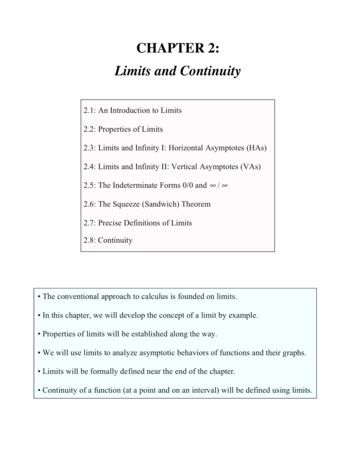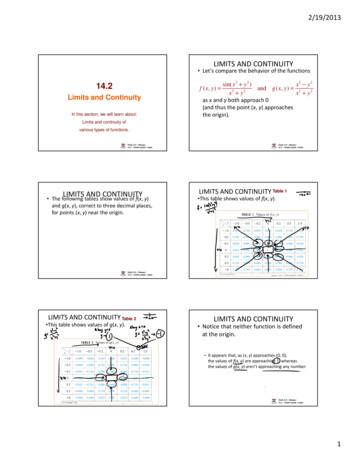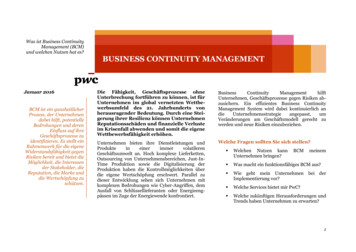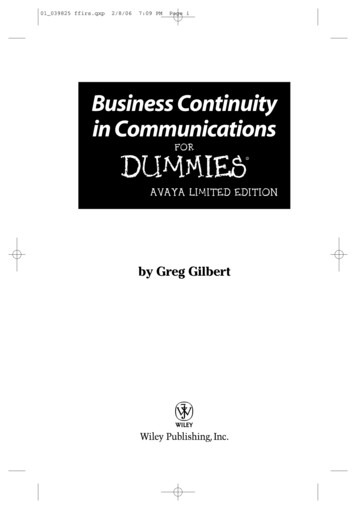
Transcription
CHAPTER 2:Limits and Continuity2.1: An Introduction to Limits2.2: Properties of Limits2.3: Limits and Infinity I: Horizontal Asymptotes (HAs)2.4: Limits and Infinity II: Vertical Asymptotes (VAs)2.5: The Indeterminate Forms 0/0 and / 2.6: The Squeeze (Sandwich) Theorem2.7: Precise Definitions of Limits2.8: Continuity The conventional approach to calculus is founded on limits. In this chapter, we will develop the concept of a limit by example. Properties of limits will be established along the way. We will use limits to analyze asymptotic behaviors of functions and their graphs. Limits will be formally defined near the end of the chapter. Continuity of a function (at a point and on an interval) will be defined using limits.
(Section 2.1: An Introduction to Limits) 2.1.1SECTION 2.1: AN INTRODUCTION TO LIMITSLEARNING OBJECTIVES Understand the concept of (and notation for) a limit of a rational function at apoint in its domain, and understand that “limits are local.” Evaluate such limits. Distinguish between one-sided (left-hand and right-hand) limits andtwo-sided limits and what it means for such limits to exist. Use numerical / tabular methods to guess at limit values. Distinguish between limit values and function values at a point. Understand the use of neighborhoods and punctured neighborhoods in theevaluation of one-sided and two-sided limits. Evaluate some limits involving piecewise-defined functions.PART A: THE LIMIT OF A FUNCTION AT A POINT()Our study of calculus begins with an understanding of the expression lim f x ,x awhere a is a real number (in short, a ) and f is a function. This is read as:“the limit of f ( x ) as x approaches a.” WARNING 1: means “approaches.” Avoid using this symbol outsidethe context of limits. lim is called a limit operator. Here, it is applied to the function f .x a()lim f x is the real number that f ( x ) approaches as x approaches a, if such ax anumber exists. If f ( x ) does, indeed, approach a real number, we denote thatnumber by L (for limit value). We say the limit exists, and we write:()lim f x L , orx a()f x L as x a .These statements will be rigorously defined in Section 2.7.
(Section 2.1: An Introduction to Limits) 2.1.2()When we evaluate lim f x , we do one of the following:x a We find the limit value L (in simplified form).()We write: lim f x L .x a We say the limit is (infinity) or (negative infinity).()()We write: lim f x , or lim f x .x ax a We say the limit does not exist (“DNE”) in some other way.()We write: lim f x DNE.x a(The “DNE” notation is used by Swokowski but few other authors.)If we say the limit is or , the limit is still nonexistent. Think of and as “special cases of DNE” that we do write when appropriate; they indicate whythe limit does not exist.()lim f xx aexistsdoes not existThe limit is a real number, L.“DNE” ()lim f x is called a limit at a point, because x a corresponds to a point on thex areal number line. Sometimes, this is related to a point on the graph of f .Example 1 (Evaluating the Limit of a Polynomial Function at a Point)()()Let f x 3x 2 x 1 . Evaluate lim f x .x 1§ Solutionf is a polynomial function with implied domain Dom ( f ) .()We substitute (“plug in”) x 1 and evaluate f 1 .()WARNING 2: Sometimes, the limit value lim f x does not equal()the function value f a . (See Part C.)x a
(Section 2.1: An Introduction to Limits) 2.1.3()()lim f x lim 3x 2 x 1x 1x 1WARNING 3: Use grouping symbols when taking the limit ofan expression consisting of more than one term.() ()2 3 1 1 1WARNING 4: Do not omit the limit operator lim until thisx 1substitution phase.WARNING 5: When performing substitutions, be prepared touse grouping symbols. Omit them only if you are sure they areunnecessary. 3()()We can write: lim f x 3 , or f x 3 as x 1.x 1 Be prepared to work with function and variable names other than f and x.For example, if g t 3t 2 t 1 , then lim g t 3 , also.()t 1()()The graph of y f x is below.Imagine that the arrows in the figurerepresent two lovers running towards eachother along the parabola. What is they-coordinate of the point they areapproaching as they approach x 1?It is 3, the limit value.TIP 1: Remember that y-coordinates ofpoints along the graph correspond tofunction values. §
(Section 2.1: An Introduction to Limits) 2.1.4Example 2 (Evaluating the Limit of a Rational Function at a Point)()Let f x 2x 1. Evaluate lim f x .x 3x 2()§ Solution( ) {}f is a rational function with implied domain Dom f x x 2 .We observe that 3 is in the domain of f ( in short, 3 Dom ( f )) , so we()substitute (“plug in”) x 3 and evaluate f 3 .()2x 1x 3 x 22 3 1lim f x limx 3 ()(3) 2 7()The graph of y f x is below.Note: As is often the case, you might notknow how to draw the graph until later. Asymptotes. The dashed lines are asymptotes, which are lines that agraph approaches- in a “long-run” sense(see the horizontal asymptote, or “HA,” at y 2 ), or- in an “explosive” sense(see the vertical asymptote, or “VA,” at x 2 ).“HA”s and “VA”s will be defined using limits in Sections 2.3and 2.4, respectively.
(Section 2.1: An Introduction to Limits) 2.1.5 “Limits are Local.” What if the lover on the left is running alongthe left branch of the graph? In fact, we ignore the left branch,because of the following key principle of limits.“Limits [at a Point] are Local”()When analyzing lim f x , we only consider the behaviorx aof f in the “immediate vicinity” of x a .In fact, we may exclude consideration of x a itself,as we will see in Part C.In the graph, we only care what happens “immediately around”x 3. Section 2.7 will feature a rigorous approach. §Example 3 (Evaluating the Limit of a Constant Function at a Point)lim 2 2 .x (Observe that substituting x technically works here, since there isno “x” in “2,” anyway.) A constant approaches itself. We can write 2 2 (“2 approaches 2”) asx . When we think of a sequence of numbers approaching 2, we maythink of distinct numbers such as 2.1, 2.01, 2.001, . However, theconstant sequence 2, 2, 2, is also said to approach 2. §All constant functions are also polynomial functions, and all polynomialfunctions are also rational functions. The following theorem applies to all threeExamples thus far.Basic Limit Theorem for Rational Functions( )If f is a rational function, and a Dom f ,()()then lim f x f a .x a() To evaluate the limit, substitute (“plug in”) x a , and evaluate f a .We will justify this theorem in Section 2.2.
(Section 2.1: An Introduction to Limits) 2.1.6PART B: ONE- AND TWO-SIDED LIMITS; EXISTENCE OF LIMITS()lim is a two-sided limit operator in lim f x , because we must consider thex ax abehavior of f as x approaches a from both the left and the right.()lim is a one-sided left-hand limit operator. lim f x is read as:x a x a“the limit of f ( x ) as x approaches a from the left.”()lim is a one-sided right-hand limit operator. lim f x is read as:x a x a“the limit of f ( x ) as x approaches a from the right.”Example 4 (Using a Numerical / Tabular Approach to Guess a Left-Hand LimitValue)()Guess the value of lim x 3 using a table of function values.x 3§ Solution()()()Let f x x 3 . lim f x is the real number, if any, that f xx 3approaches as x approaches 3 from lesser (or lower) numbers. That is, weapproach x 3 from the left along the real number line.We select an increasing sequence of real numbers (x values) approaching 3such that all the numbers are close to (but less than) 3. We evaluate thefunction at those numbers, and we guess the limit value, if any, the functionvalues are approaching. For example:xf x x 3()(2.92.992.9995.95.995.999 3 6 (?))We guess: lim x 3 6 .x 3WARNING 6: Do not confuse superscripts with signs of numbers.Be careful about associating the “ ” superscript with negative numbers.Here, we consider positive numbers that are close to 3. If we were taking a limit as x approached 0, then we wouldassociate the “ ” superscript with negative numbers and the “ ”superscript with positive numbers.
(Section 2.1: An Introduction to Limits) 2.1.7()The graph of y f x is below. We only consider the behavior of f“immediately” to the left of x 3.WARNING 7: The numerical / tabular approach is unreliable, and it istypically unacceptable as a method for evaluating limits on exams.(See Part D, Example 11 to witness a failure of this method.) However, itmay help us guess at limit values, and it strengthens our understanding oflimits. §Example 5 (Using a Numerical / Tabular Approach to Guess a Right-Hand LimitValue)()Guess the value of lim x 3 using a table of function values.x 3§ Solution()()()Let f x x 3 . lim f x is the real number, if any, that f xx 3approaches as x approaches 3 from greater (or higher) numbers. That is,we approach x 3 from the right along the real number line.We select a decreasing sequence of real numbers (x values) approaching 3such that all the numbers are close to (but greater than) 3. We evaluate thefunction at those numbers, and we guess the limit value, if any, the functionvalues are approaching. For example:x3 f x x 3 6 (?) ()()We guess: lim x 3 6 .x 33.0013.013.16.0016.016.1
(Section 2.1: An Introduction to Limits) 2.1.8()The graph of y f x is below. We only consider the behavior of f“immediately” to the right of x 3.§Existence of a Two-Sided Limit at a Point()()()lim f x L lim f x L, and lim f x L ,x ax a x a( a, L ) . A two-sided limit exists the corresponding left-hand and right-handlimits exist, and they are equal. If either one-sided limit does not exist (DNE), or if the two one-sidedlimits are unequal, then the two-sided limit does not exist (DNE).()()()Our guesses, lim x 3 6 and lim x 3 6 , imply lim x 3 6 .x 3x 3x 3In fact, all three limits can be evaluated by substituting x 3 into ( x 3) :limx 3 ( x 3) 3 3 6 ; x lim( x 3) 3 3 6 ; xlim( x 3) 3 3 6 . 3 3 This procedure is generalized in the following theorem.Extended Limit Theorem for Rational Functions( )f ( x ) f ( a ) , and lim f ( x ) f ( a ) .x aIf f is a rational function, and a Dom f ,()()then lim f x f a , lim x ax a() To evaluate each limit, substitute (“plug in”) x a , and evaluate f a .
(Section 2.1: An Introduction to Limits) 2.1.9WARNING 8: Substitution might not work if f is not a rational function.Example 6 (Pitfalls of Substituting into a Function that is Not Rational)()()()()Let f x x 1 . Evaluate lim f x , lim f x , and lim f x .x 0x 0x 0§ Solution( ) {})Observe that Dom f x x 0 0, , becausex 0 , but it is not real when x 0 .x is real whenThis is important, because x is only allowed to approach 0 (or whatever a is)through Dom ( f ) . Here, x is allowed to approach 0 from the right but notfrom the left.()Right-Hand Limit: lim f x 1.x 0()Substituting x 0 works: lim f x lim x 0x 0()x 1 0 1 1.()Left-Hand Limit: lim f x does not exist (DNE).x 0Substituting x 0 does not work here.()Two-Sided Limit: lim f x does not exist (DNE).x 0This is because the corresponding left-hand limit does not exist(DNE).Observe that f is not a rational function, so the aforementioned theoremdoes not apply, even though 0 Dom f . f is, however, an algebraic( )function, and we will discuss algebraic functions in Section 2.2. §
(Section 2.1: An Introduction to Limits) 2.1.10PART C: IGNORING THE FUNCTION AT aExample 7 (Ignoring the Function at ‘a’ When Evaluating a Limit;Modifying Examples 4 and 5)()()Let g x x 3, x 3 .(We are deleting 3 from the domain of the function in Examples 4 and 5;this changes the function.)()()()Evaluate lim g x , lim g x , and lim g x .x 3x 3x 3§ SolutionSince 3 Dom ( g ) , we must delete the point ( 3, 6 ) from the graph ofy x 3 to obtain the graph of g below.We say that g has a removable discontinuity at x 3 (see Section 2.8), andthe graph of g has a hole at the point ( 3, 6 ) .Observe that, as x approaches 3 from the left and from the right,g ( x ) approaches 6, even though g ( x ) never equals 6.()g 3 is undefined, yet the following statements are true:()lim g ( x ) 6 , andx 3 lim g ( x ) 6 .x 3lim g x 6 ,x 3 There literally does not have to be a point at x 3 (in general, x a ) forthese limits to exist! Observe that substituting x 3 into ( x 3) works. §
(Section 2.1: An Introduction to Limits) 2.1.11Example 8 (Ignoring the Function at ‘a’ When Evaluating a Limit;Modifying Example 7) x 3, x 3Let the function h be defined piecewise as follows: h x .x 3 7,()(A piecewise-defined function applies different evaluation rules to differentsubsets of (groups of numbers in) its domain. This type of function can leadto interesting limit problems.)()Evaluate lim h x .x 3§ Solutionh is identical to the function g from Example 7, except that 3 Dom ( h ) , andh ( 3) 7 . As a result, we must add the point ( 3, 7 ) to the graph of g toobtain the graph of h below.As with g, h also has a removable discontinuity at x 3, and its graph alsohas a hole at the point ( 3, 6 ) .Observe that, as x approaches 3 from the left and from the right,h ( x ) also approaches 6.()()lim h x 6 once again, even though h 3 7 .x 3WARNING 2 repeat (applied to f ): Sometimes, thelimit value lim f x does not equal the function value f a . §x a()()As in Example 7, observe that substituting x 3 into ( x 3) works. §
(Section 2.1: An Introduction to Limits) 2.1.12()The existence (or value) of lim f x need not depend on thex aexistence (or value) of f ( a ) .()lim f ( x ) f ( a ) ,x a Sometimes, it does help to know what f ( a ) is when evaluating lim f x .x aIn Section 2.8, we will say that f is continuous at a ()()provided that lim f x and f a exist. We appreciate continuity, because wex acan then simply substitute x a to evaluate a limit, which was what we did whenwe applied the Basic Limit Theorem for Rational Functions in Part A. In Examples 7 and 8, we dealt with functions that were not continuous at x 3,yet substituting x 3 into ( x 3) allowed us to evaluate the one- and two-sidedlimits at a 3. We will develop theorems that cover these Examples. We first needthe following definitions.A neighborhood of a is an open interval along the real number line that issymmetric about a.For example, the interval ( 0, 2 ) is a neighborhood of 1. Since 1 is themidpoint of ( 0, 2 ) , the neighborhood is symmetric about 1.A punctured (or deleted) neighborhood of a is constructed by taking aneighborhood of a and deleting a itself.For example, the set ( 0, 2 ) \ {1} , which can be written as ( 0, 1) (1, 2 ) ,is a punctured neighborhood of 1. It is a set of numbers that are“immediately around” 1 on the real number line. The notation ( 0, 2 ) \ {1} indicates that we can construct it by takingthe neighborhood ( 0, 2 ) and deleting 1.
(Section 2.1: An Introduction to Limits) 2.1.13“Puncture Theorem” for Limits of Locally Rational FunctionsLet r be a rational function, and let a Dom ( r ) .Let f ( x ) r ( x ) on a punctured neighborhood of x a .()() ()Then, lim f x lim r x r a .x ax a To evaluate the limits, substitute (“plug in”) x a into r ( x ) , and()evaluate r a . That is, if a function rule is given by a rational expression r ( x )locally (immediately) around x a , where a Dom ( r ) , thenevaluate the rational expression at a to obtain the limit of thefunction at a.Refer to Examples 7 and 8. Let r ( x ) x 3 . Observe that r is a rational function,and 3 Dom ( r ) . Both the g and h functions were defined by x 3 locally(immediately) around x 3. More precisely, they were defined by x 3 on somepunctured neighborhood of x 3, say ( 2.9, 3.1) \ {3} . Therefore,()x 3()x 3()x 3()x 3() ()lim g x lim r x r 3 3 3 6 , andx 3() ()lim h x lim r x r 3 3 3 6 .x 3It is easier to write:()()lim g x lim x 3 3 3 6 , andx 3lim h x lim x 3 3 3 6 .x 3The figure below refers to g, but it also applies to h.The dashed line segment at x 3 reiterates the puncture there.
(Section 2.1: An Introduction to Limits) 2.1.14Why does the theorem only require that a function be locally rational about a?Consider the following Example.Example 9 (Limits are Local) t 2,Let f t t ,()t 0t 0(). Evaluate lim f t .t 1§ SolutionObserve that f ( t ) t 2 is the only rule that is relevant as t approaches 1locally from the left and from the right. We only consider values of t thatare “immediately around” a 1 . “Limits are Local!”It is irrelevant that the rule f ( t ) t is different, or that it is not rational. §The following definitions will prove helpful in our study of one-sided limits.A left-neighborhood of a is an open interval of the form ( c, a ) , where c a .A right-neighborhood of a is an open interval of the form ( a, c ) , where c a .A punctured neighborhood of a consists of both a left-neighborhood of a anda right-neighborhood of a.For example, the interval ( 0, 1) is a left-neighborhood of 1. It is a set ofnumbers that are “immediately to the left” of 1 on the real number line.The interval (1, 2 ) is a right-neighborhood of 1. It is a set of numbers thatare “immediately to the right” of 1 on the real number line.We now modify the “Puncture Theorem” for one-sided limits.() Basically, when evaluating a left-hand limit such as lim f x , we use thex afunction rule that governs the x-values “immediately to the left” of a on the realnumber line.() Likewise, when evaluating a right-hand limit such as lim f x , we use thex arule that governs the x-values “immediately to the right” of a.
(Section 2.1: An Introduction to Limits) 2.1.15Variation of the “Puncture Theorem” for Left-Hand LimitsLet r be a rational function, and let a Dom ( r ) .Let f ( x ) r ( x ) on a left-neighborhood of x a .()() ()Then, lim f x lim r x r a .x ax aVariation of the “Puncture Theorem” for Right-Hand LimitsLet r be a rational function, and let a Dom ( r ) .Let f ( x ) r ( x ) on a right-neighborhood of x a .()() ()Then, lim f x lim r x r a .x ax aExample 10 (Evaluating One-Sided and Two-Sided Limits of a Piecewise-DefinedFunction) 3,if x 0 2Let f x 2x , if 0 x 1 . 2x, if x 1 ()Evaluate the one-sided and two-sided limits of f at 1 and at 0.§ Solution()The graph of y f x is below. It helps, but it is not required to evaluatelimits. Instead, we can evaluate limits of relevant function rules.
(Section 2.1: An Introduction to Limits) 2.1.16()lim f x lim 2x 2x 1x 1() 2 12()(lim f x lim 2xx 1() 2 1 2()lim f x 2x 1()lim f x lim 3x 0 x 0 3()x 0() 2 02 0()lim f xx 0does not exist (DNE)§)The right-hand limit as x 1 :()We use the rule f x 2x , because itapplies to a right-neighborhood of 1,say 1, 1.1 .()The two-sided limit as x 1 :The left-hand and right-hand limits at 1exist, and they are equal, so the two-sidedlimit exists and equals their common value.The left-hand limit as x 0 :We use the rule f ( x ) 3 , because itapplies to a left-neighborhood of 0,say 0.1, 0 .(lim f x lim 2x 2x 0()We use the rule f x 2x 2 , because itapplies to a left-neighborhood of 1,say 0.9, 1 . 2x 1 The left-hand limit as x 1 :)The right-hand limit as x 0 :()We use the rule f x 2x 2 , because itapplies to a right-neighborhood of 0,say 0, 0.1 .()The two-sided limit as x 0 :The left-hand and right-hand limits at 0exist, but they are unequal, so thetwo-sided limit does not exist (DNE).
(Section 2.1: An Introduction to Limits) 2.1.17PART D: NONEXISTENT LIMITSExample 11 (Nonexistent Limits) 1 Let f x sin . Evaluate lim f x , lim f x , and lim f x .x 0x 0x 0 x ()()()()§ SolutionThe graph of y f ( x ) is below. Ask your instructor if s/he might have youeven attempt to draw this. In a sense, the classic sine wave is being turned“inside out” relative to the y-axis.As x approaches 0 from the right(or from the left), the function valuesoscillate between 1 and 1.They do not approach a single realnumber. Therefore,()lim f ( x ) does not exist (DNE), andx 0 lim f ( x ) does not exist (DNE).x 0lim f x does not exist (DNE),x 0 Note 1: The y-axis is not a vertical asymptote (VA) here, because the graphand the function values are not “exploding” without bound around they-axis.Note 2: Here is an example of how the numerical / tabular approachintroduced in Part B might lead us astray:x0 1 f x sin x 0 (?) ()§NO!13 12 1 000
(Section 2.1: An Introduction to Limits) 2.1.18Example 12 (Infinite and/or Nonexistent Limits)()Let f x ()()()1. Evaluate lim f x , lim f x , and lim f x .x 0x 0x 0x§ SolutionThe graph of y f ( x ) is below. We will discuss this graph in later sections.As x approaches 0 from the right, thefunction values increase without bound.()Therefore, lim f x .x 0As x approaches 0 from the left, thefunction values decrease without bound.()Therefore, lim f x .x 0 and are mismatched.()Therefore, lim f x does not exist (DNE).x 0()In fact, all three limits do not exist. For example, lim f x , does notx 0exist, because the function values do not approach a single real number asx approaches 0 from the right. The expressions and indicate why theone-sided limits do not exist, and we write and where appropriate. §Example 13 (Infinite and Nonexistent Limits)()Let f x ()()()1. Evaluate lim f x , lim f x , and lim f x .x 0x 0x 0x2§ SolutionThe graph of y f ( x ) is below. Observe that f is an even function.()lim f ( x ) , andx 0 lim f ( x ) . §x 0lim f x ,x 0
(Section 2.1: An Introduction to Limits) 2.1.19Example 14 (A Nonexistent Limit)()Let f x xx()()(). Evaluate lim f x , lim f x , and lim f x .x 0x 0x 0§ SolutionNote: f is not a rational function, but it is an algebraic function, sincexx2f x .xx() x, if x 0Remember that: x . x,ifx 0 x x 1, if x 0xThen, f x , and f 0 is undefined. x x 1, if x 0 x()()The graph of y f ( x ) is below.()lim f ( x ) 1 , andx 0 lim f ( x ) does not exist (DNE),x 0lim f x 1,x 0 due to the fact that the right-hand and left-hand limits areunequal. §
(Section 2.1: An Introduction to Limits) 2.1.20.FOOTNOTES1. Limits do not require continuity. In Section 2.8, we will discuss continuity, a property offunctions that helps our lovers run along the graph of a function without having to jump orhop. In Exercises 1-3, we could imagine the lovers running towards each other (one from theleft, one from the right) while staying on the graph of f and without having to jump or hop,provided they were placed on appropriate parts of the graph. Sometimes, the “run” requires 0, if x is a rational number x .jumping or hopping. Let f x x, if x is an irrational number x ; really, x \ It turns out that lim f x 0 .(()x 0()())2. Misconceptions about limits.See “Why Is the Limit Concept So Difficult for Students?” by Sally Jacobs in the Fall 2002edition (vol.24, No.1) of The AMATYC Review, pp.25-34. Students can be misled by the use of the word “limit” in real-world contexts. For example, aspeed limit is a bound that is not supposed to be exceeded; there is no such restriction onlimits in calculus. Limit values can sometimes be attained. For example, if a function f is continuous atx a (see Examples 1-3), then the function value takes on the limit value at x a . Limit values do not have to be attained. See Examples 7 and 8.Observations: The dynamic view of limits, which involves ideas of motion and “approaching”(for example, our lovers), may be more accessible to students than the static view preferredby many textbook authors. The static view is exemplified by the formal definitions of limitswe will see in Section 2.7. The dynamic view greatly assists students in transitioning to thestatic view and the formal definitions. Leading mathematicians in 18th- and 19th-century Europe heatedly debated ideas of limits.3. Multivariable calculus. When we go to higher dimensions, there may be more than twopossible approaches (not just left-hand and right-hand) when analyzing limits at a point!Neighborhoods can take the form of disks or balls.4. An example where a left-hand limit exists but not the right-hand limit. 1if x 0 x sin ,x x 1 x x 1 .Let f x sin x x 2 x sin 1 , if x 0 x (())()()Then, lim f x 0 , which can be proven by the Squeeze (Sandwich) Theorem inx 0()Section 2.6. However, lim f x does not exist (DNE).x 0See William F. Trench, Introduction to Real Analysis (free online /TRENCH REAL ANALYSIS.PDF), p.39.
(Section 2.1: An Introduction to Limits) 2.1.3 lim x 1 fx() lim x 1 3x2 x 1 WARNING 3: Use grouping symbols when taking the limit of an expression consisting of more than one term. 31











